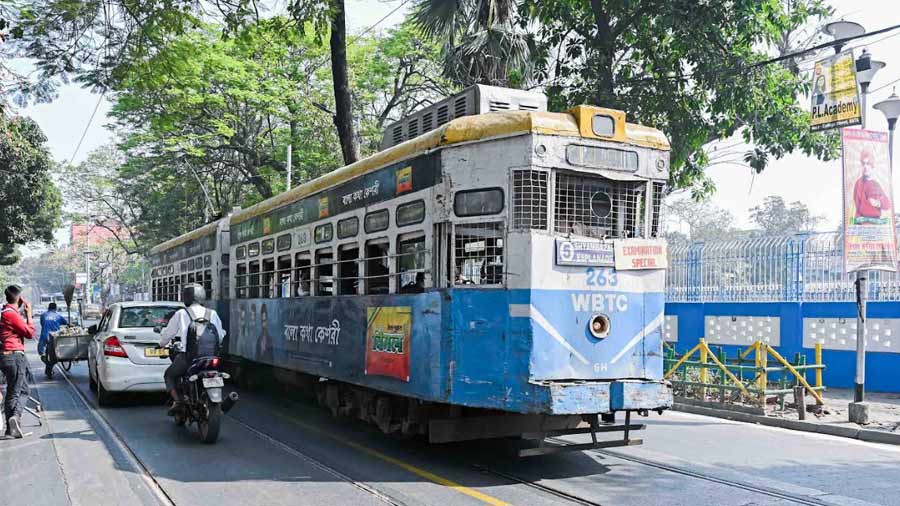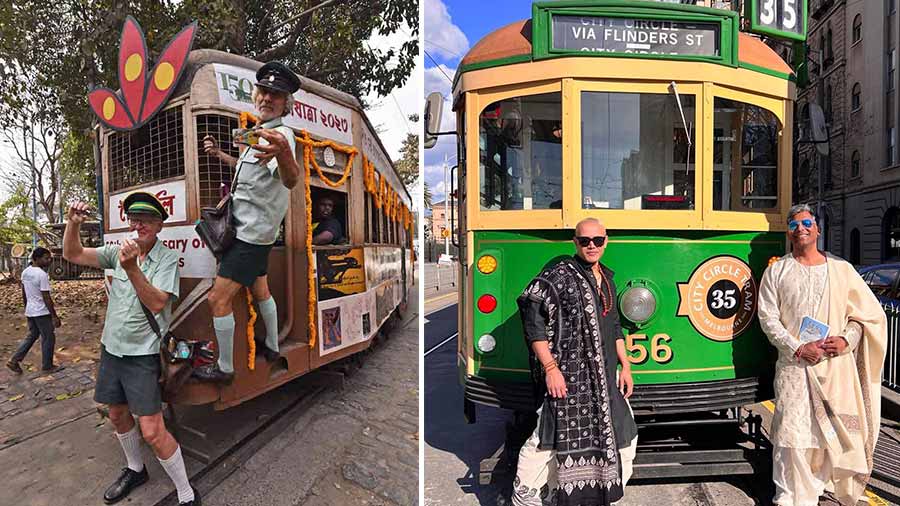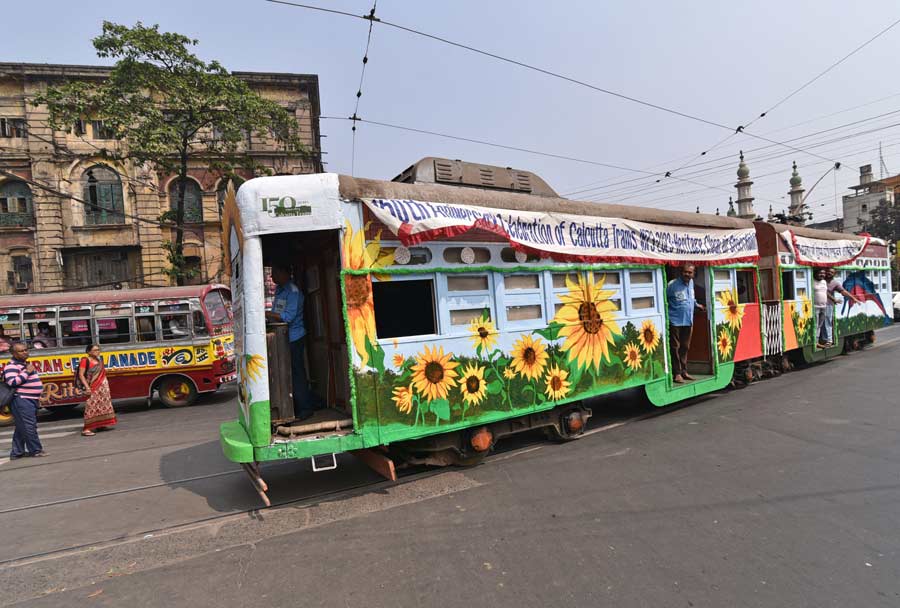Dear Didi,
I write to you from Melbourne. I am a retired tram driver-cum-conductor and activist. I was also part of the group that initiated the Melbourne-Kolkata Tramjatra all of 29 years ago. During this long journey, I have curated tram festivals in both cities, and have also had the fortune of working closely with tram workers and tram enthusiasts in Kolkata.
It would be an understatement to say that our cities and people know each other well. Over the years, both Kolkata and Melbourne have worked in tandem to decorate trams with cultural, heritage and environmental themes. Together, we have showcased a tram festival — Tramjatra — with performances by tram conductors, tram plays, films and songs. During the first decade of this century, we have also shared technical tramway information and helped with track renewal in Kolkata.

A decorated tram at the Tramjatra 2023 Soumyajit Dey
Incidentally, Tramjatra has always involved governments in both West Bengal and Victoria over the last three decades, forging a yet deeper tramway friendship between the two cities. This year, for instance, we partnered with Bengal's transport department and the West Bengal Transport Corporation (WBTC) to stage another very successful season of Tramjatra. Tramjatra 2023, which coincided with the 150th anniversary of Kolkata’s tramways, saw historic tram parades, wooden-bodied trams being decorated, children participating in an art exhibition and a series of brainstorming events.In 1994, on the very first day of my holiday in Kolkata, I remember being greatly intrigued by that familiar gong of trams and a friendly group of tram workers I met in Esplanade. They took me to the Belgachia tram depot, and, almost instantly, a long-term friendship between Melbourne and Kolkata (Calcutta, at that time) was born.
Over the years, however, the importance of trams in Kolkata’s transport structure has steadily dwindled. Today, I write to you with a request. Please consider prioritising trams in Kolkata’s public transport infrastructure. Given the backdrop of rising air pollution and climate change impacts, this, you will find, is a trend in most major cities of the world.

Tony Graham and Roberto D'Andrea pose with tram cards to promote Tramjatra 2023 at Esplanade tram terminus Suvendu Das
A bit of history will not be out of place. Both Kolkata and Melbourne started their tramways within a few years of each other — Kolkata in 1873 and Melbourne in 1885. This was a time when cities worldwide were laying tracks and building tramcars. Even in the 1950s and 1960s, decades when cars, freeways, and buses had all started to impinge on the efficacy of tram systems the world over, Kolkata and Melbourne succeeded in retaining their trams.
Kolkata and Melbourne are part of a unique global tram family, which also includes other international cities such as Hong Kong, Toronto, San Francisco, Amsterdam, Prague, Budapest, Vienna, Zurich, Cologne, Berlin, Milan, Rome and Torino. Tram services in all these cities were, thankfully, never fully interrupted. To help lower the traffic congestion and the impacts of air pollution and climate change, new tramways (often called light rail) have returned to around 440 cities across the globe since the 1990s. Cities like Alexandria, Manchester, Sheffield, Edinburgh, Manila, Los Angeles, Boston, Dallas, Rio de Janeiro and Sydney have all either rebuilt or extended their extensive tramway systems in this time.

A refurbished tram from the 1920s that now runs in Christchurch, Melbourne
Didi, Kolkata is today one of the most polluted metros in the world. Climate change also threatens the future of Bengal, since a large number of people here live in an arc around the Bay of Bengal. We all have a responsibility to act. If the world continues to use fossil fuels and release carbon dioxide into the air, we will be left with a warmer atmosphere, stronger cyclones, and a sharper rise in sea levels. It is our duty to protect the largest mangrove forest in the world, the Sunderbans, as such habitats act as buffers for cities like Kolkata.In order to combat air pollution and climate change, it becomes essential for us to decarbonise and clean up the transport sector in all of India’s major cities, including Kolkata. Cities like Melbourne are now using renewable energy to run trams and trains, and Kolkata, one feels, can surely replicate this act. I congratulate you for building more Metro lines and purchasing battery-powered buses, but I believe more needs to be done in the sector, and, perhaps, greater investment in Kolkata’s tramways is the missing link.

Tramways were started in Kolkata (in picture) and in Melbourne about 10 years apart in the late 1800s Amit Datta
With several Indian cities thinking of bringing back trams, Kolkata, with its 150-year experience of continuous tramway use, is in a unique position to lead the way. I do not think money will be a deterrent. If your government seriously proclaims its support for trams, I am certain that global capital will make itself available. While discussing ways and means to resurrect Kolkata’s tram system with its tram enthusiasts and tram users, the following suggestions came up:
- A heritage tag can go hand in hand with a high frequency of trams on the roads.
- Short-term, medium-term and long-term investment in the tramways can be looked into as part of your government’s focus on public transport, particularly electrical vehicles.
- In order to improve frequency and quickly transfer knowledge from retiring tram workers, please start giving employment to a new generation of tram drivers and conductors.
- Reactivate Nonapukur Tram Workshop, so that many more trams, presently idling in several depots with minor technical glitches, can be added to the functional fleet.
- Like in the past, a dedicated ‘right of way’ reservation for a fast and reliable tramway service can be reintroduced in Kolkata, wherever possible.
- Platform tram stops (a separate zone in the road when trams are moving through the middle of thoroughfares without a dedicated track) are required to ensure safety of passengers while embarking and disembarking.
- The city requires a fast and modern light-rail-style service between its rail and Metro stations.
- Like in several international cities, trams should get priority in the traffic signalling system of Kolkata.
- Closed tram routes and depots should gradually be reopened. Priority must be given to the likes of route 36 which runs between Kidderpore and Esplanade via the Maidan. There is a huge demand for such stretches.
- Engage with both national and international transport experts to chalk out a commercially viable tram rejuvenation blueprint for the city, as well as technical overhauling, upgradation and modernisation, including the use of solar power to run trams.
Didi, as relations between India and Australia continue to grow, Melbourne and Victoria will be more than happy to be a co-passenger and partner in putting Kolkata’s struggling trams back on track. Please act now to save the city’s trams.Yours sincerely,
Roberto D’Andrea
As communicated to The Plurals News Network


